Historical general diagnostic artefacts

AM.02.478 - Early form of syringe
Calibrated metal plunger in glass tube. Black plastic(?) perforated (male attachment) end, 80 mm. This fits into the curved metal delivery tube with female attachment, 165 mm.
Contained in black leather covered box with purple satin and velvet linings, and corroded metal clasp.
'PURE' stamped into base of delivery tube.

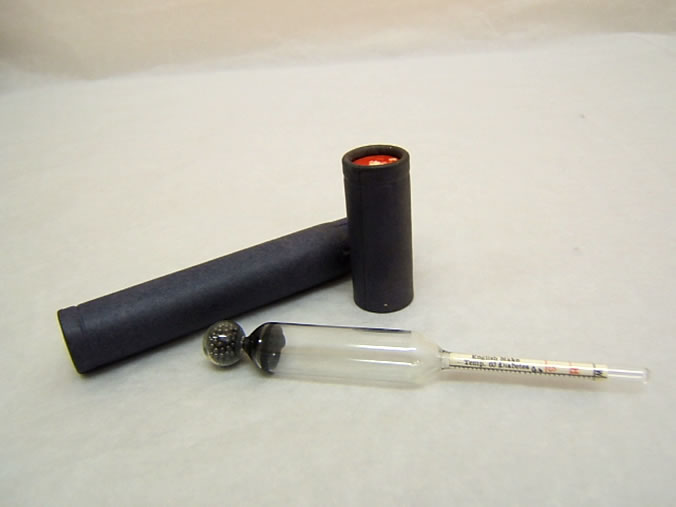
AM.02.511 - Hydrometer
To measure specific gravity of urine.

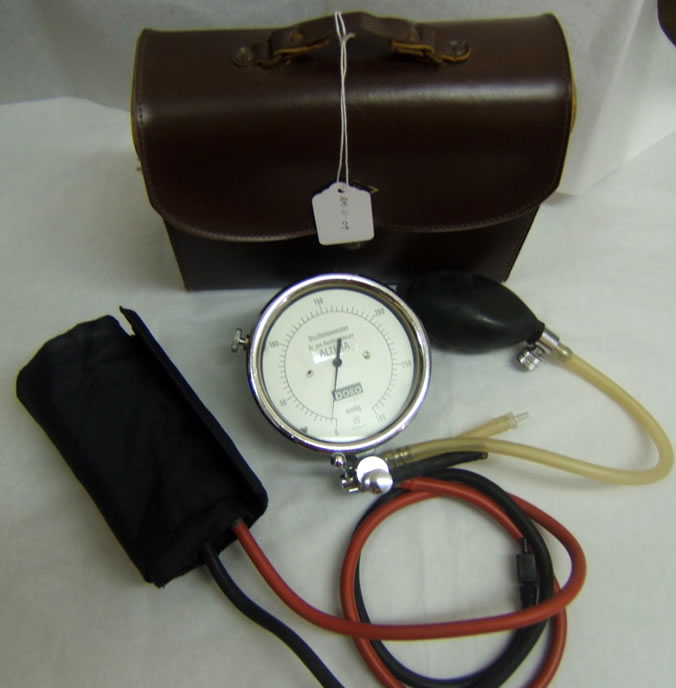
AM.11.04 - Oscillotonometer, Dr Von Recklinghousen
'ALTERA', baso, mmHg Germany.
Meter goes from 0 to 300.
With tubing pump, control valve and twin pocket armlet. In leather covered case with 'MIE' in gold triangle above latch.

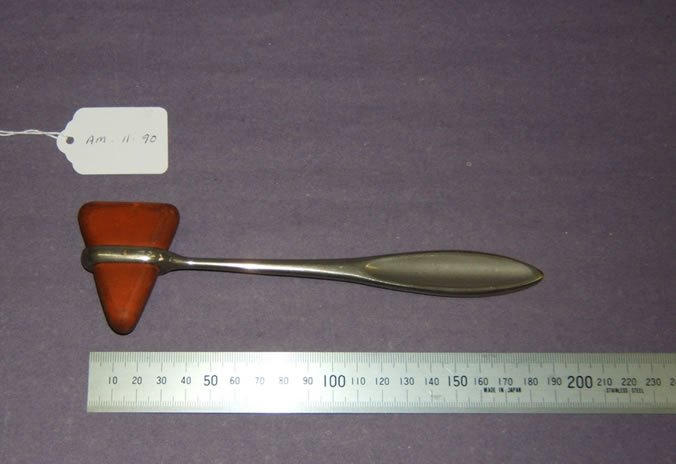
AM.11.90 - Percussor
Taylor's, chromium plated, with solid rubber triangular head.

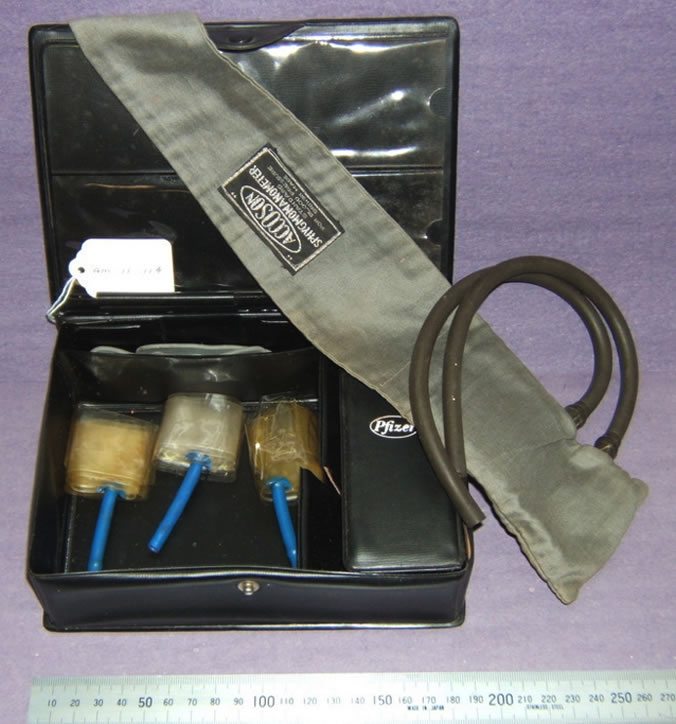
AM.11.114 - Sphygmomanometer
Paediatrics Sphygmomanometer, ACCOSAN, standard for blood pressure, British made on cuff.
Attachments in Pfizer plastic box with compartments, and dome to close lid.
Dr D. S. MALCOLM written in pen on fabric cuff

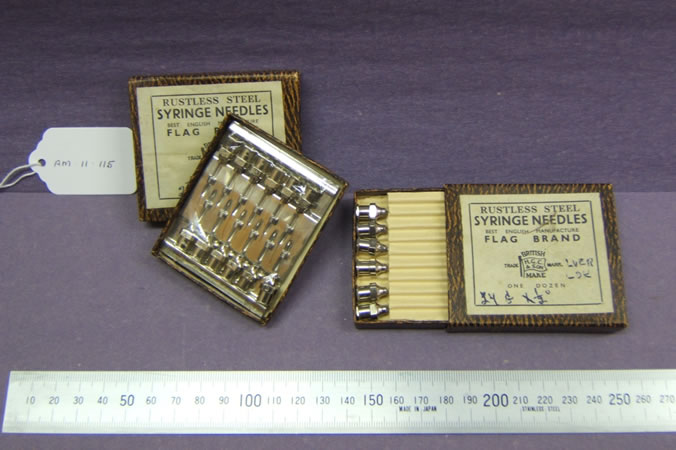
AM.11.115 a-b - Rustless steel syringe needles
'BEST ENGLISH MANUFACTURE, FLAG BRAND' - Leur Lok.
- One dozen 27G x 1/2'
- One dozen 27G x 5/8'
'BRITISH MADE, TRADE MARK H.G.C. & SON'

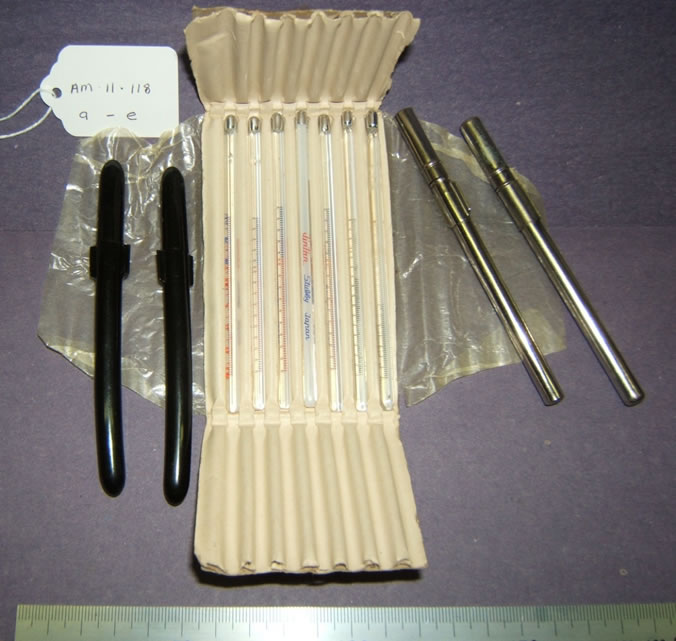
AM.11.118 a-e
- Bakelite cased thermometer, 1/2 min DISKA BULBS Made in England guaranteed.
- Bakelite cased thermometer, 1/2 Min G.H.ZEAL made in England guaranteed.
- Metal cased thermometer, UNICC 1/2 Min, with Lid slightly caroded.
- Metal cased thermometer, Richard Thomson & Co. Sydney, 1/2 Min G.H.ZEAL English Made Guaranteed.
- Cardboard Pkt. containing 5 x Jintan Stubby Japan thermometers
and 1 x 1 Min G.H.ZEAL English made, and 1 x 1/2 Min G.H.ZEAL English made.

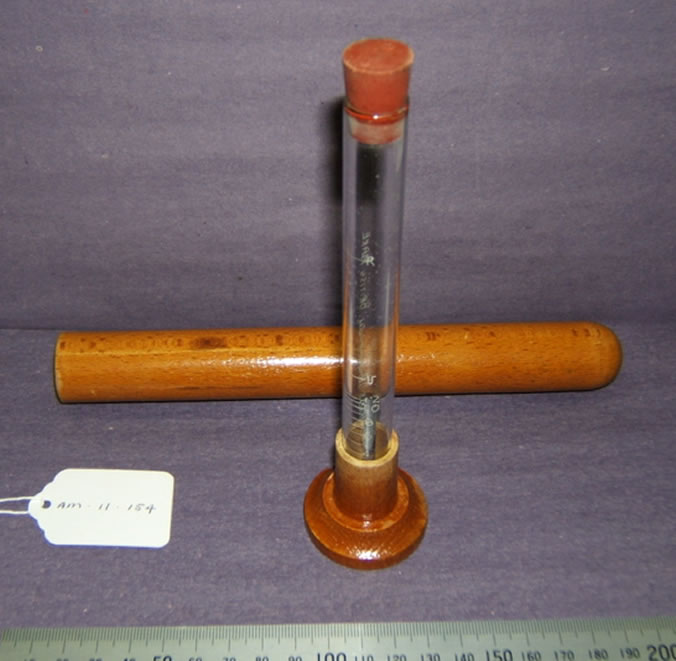
AM.11.154 - Albuminometer
Esbach's Albuminometer; for testing the albumen in urine. Esbach's albumenometer used a simple chemical test to measure the amount of the protein albumen in urine. The instrument is made of glass and wood. It is contained in a wooden case.
Urine was filled to the ‘U’ mark and a chemical reagent to the ‘R’ mark. The substance stood for 24 hours before the protein levels were assessed. Unusual levels of albumen in the urine can indicate kidney problems. It is named after its inventor, French physician, G H Esbach (1843-90).
Urine was one of the first substances to be scientifically scrutinised in the 1800s. It could be examined easily and could show obvious signs of disease.


AM.11.168 - All glass syringe with glass plunger
Patented 25 April 1905.
P.J.McElroy. East Cambridge Mass.

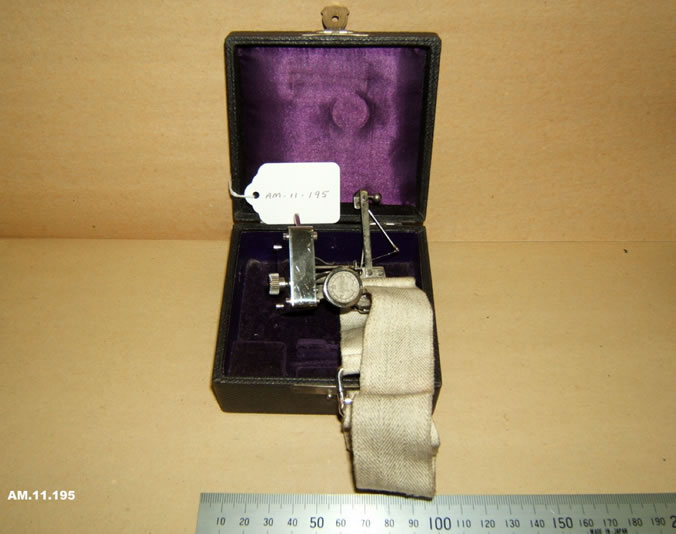
AM.11.195 - Sphygmograph
Contained in box 9 cm x 9.8 cm, lined with purple satin and purple velvet.
Stamped on to screw Roman numerals I - II- III- IV, OZ TROY, with linen wrist strap.
Force, rate and variations in the pulse were recorded using a sphygmograph. The first practical version was devised in 1860 by French physician Etienne-Jules Marey (1830-1904)
English physician and homeopath Robert Ellis Dudgeon (1820-1904) introduced this new, highly portable sphygmograph in 1881. It was strapped to the wrist. The pulse at the wrist caused a metal strip to move a stylus. This transmitted a record of the pulse onto smoked paper. It created a record of blood pressure and pulse over time. Dudgeon's instrument quickly became popular because it was compact and easy to use.

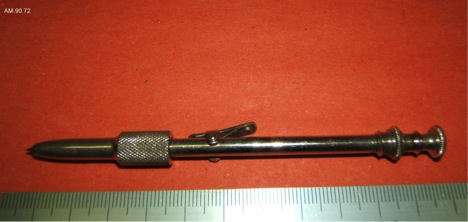
AM.90.72 - Patient stabber
Contained in box 9 cm x 9.8 cm, lined with purple satin and purple velvet.
Used to prick fingers for blood samples. On pressing the trigger on the shaft the needle flicks out at the tip to pearse the skin so blood can appear for a sample.

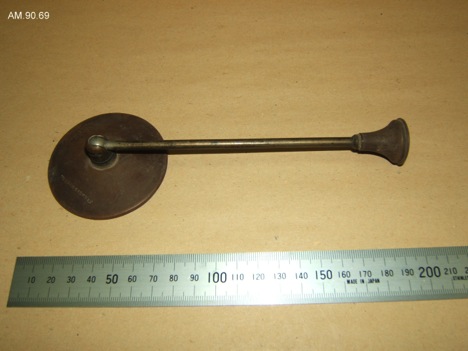
AM.90.69 - Bakelite stethoscope
Bakelite stethoscope, with small 'bell' ear attachment, joined to a listening rod. Flat Bakelite disk at base for pressing against the patient.
Make pressed on top of the listening disk "EVANS and WORMULL".
Belonged to Dr. Joseph Crocome. Licensed by the Royal College of surgeons in 1833 and who arrived at Weller's Whaling station Otakou in 1836.

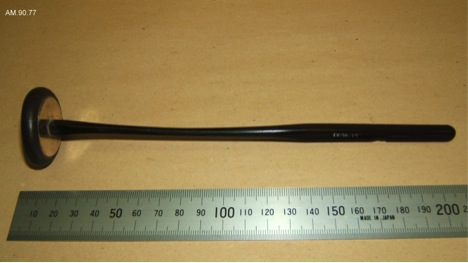
AM.90.77 - Patellar hammer
Patellar hammer with a long black Bakelite handle, stainless steel weighted hammer end with a rubber tyre like ring around the head of the hammer, for the patients comfort.
Stamped into the Chrome head "BRITISH MADE"

AM.90.91 A and AM0.90.94 - Early monaural stethoscopes
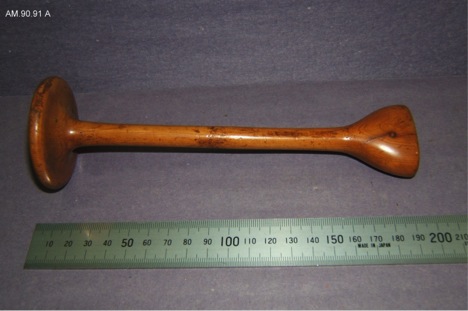
AM.90.91 A
Early monaural stethoscope presented by Mr. H.C. Manson, who was the first technical officer of the Department of Physiology.
Monaural stethoscope: made of varnished wood (one piece) with a flat spherical base and a flattened flared listening funnel. 18cm in height.
Chest examination in clinical Medicine uses four steps: Inspection - palpitation - percussion - auscultation.
Percussion was introduced into medicine in 1761 by Auenbrugger in Vienna. In 1819 Laenecc in Paris noted children listening to heart sound with a paper tube.
This stethoscope, monaural in type evolved from Laenecc stethoscopes.
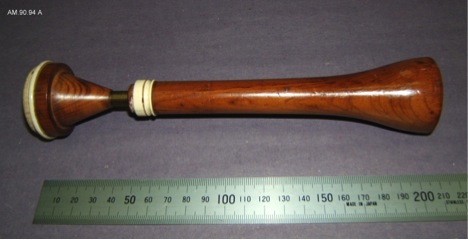
AM.90.94 a
a - Wooden monaural stethoscope (two pieces) with ivory embelishment, and a brass connection tube between earpiece and wooden chest piece.
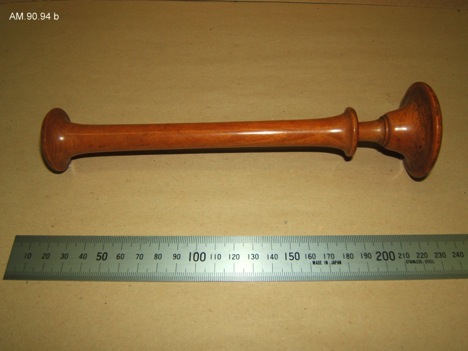
AM.90.94 b
b - Turned wood (two pieces), monaural stethoscope 20.5cm in length.
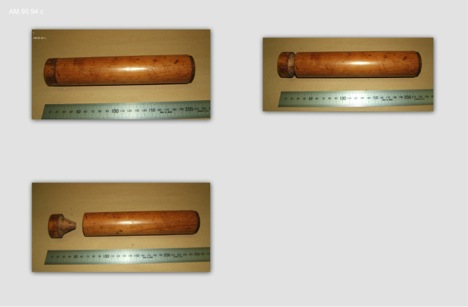
AM.90.94 c c - Wooden stethoscope monaural 21.5cm in length
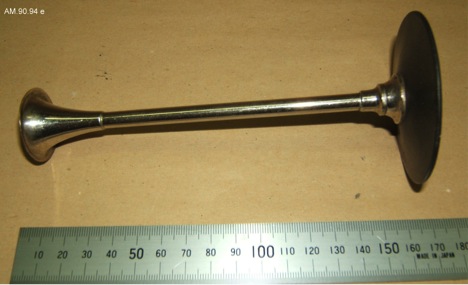
AM.90.94 e
e - Silver and Bakelite Monaural stethoscope 15.8cm long
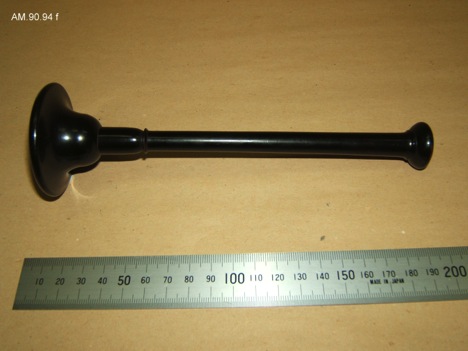
AM.90.94 f
f - Bakelite Monaural Stethoscope 18.5cm in length

|

